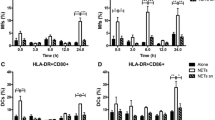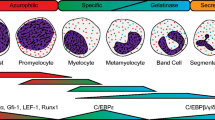Abstract
Polymorphonuclear leukocytes (PMN) contribute to bacterial clearance by uptake and intracellular killing of microbes. However, antimicrobial polypeptides are released extracellularly where they are enweaved in a chromatin web that traps and eliminates bacteria. In addition, PMN-derived antimicrobial polypeptides direct monocytes and macrophages to the site of infection and activate their antimicrobial armor. Increased expression of Fcγ receptors as well as opsonization of bacteria by PMN granule proteins support bacterial uptake by macrophages. PMN granule proteins also increase intracellular reactive oxygen species formation in macrophages. Finally, apoptotic PMN transfer parts of their antimicrobial peptides to macrophages, hence increasing killing of intracellular bacteria. Understanding mechanisms by which PMN granule proteins stimulate antimicrobial mechanisms in macrophages may open novel strategies in fighting bacterial infections.


Similar content being viewed by others
References
Lekstrom-Himes JA, Gallin JI (2000) Immunodeficiency diseases caused by defects in phagocytes. N Engl J Med 343:1703–1714
Dale DC, Boxer L, Liles WC (2008) The phagocytes: neutrophils and monocytes. Blood 112:935–945
Levy O (2004) Antimicrobial proteins and peptides: anti-infective molecules of mammalian leukocytes. J Leukoc Biol 76:909–925
Lominadze G, Powell DW, Luerman GC, Link AJ, Ward RA, McLeish KR (2005) Proteomic analysis of human neutrophil granules. Mol Cell Proteomics 4:1503–1521
Faurschou M, Borregaard N (2003) Neutrophil granules and secretory vesicles in inflammation. Microbes Infect 5:1317–1327
Uriarte SM, Powell DW, Luerman GC, Merchant ML, Cummins TD, Jog NR, Ward RA, McLeish KR (2008) Comparison of proteins expressed on secretory vesicle membranes and plasma membranes of human neutrophils. J Immunol 180:5575–5581
Borregaard N, Sørensen OE, Theilgaard-Mönch K (2007) Neutrophil granules: a library of innate immunity proteins. Trends Immunol 28:340–345
Brogden KA (2005) Antimicrobial peptides: pore formers or metabolic inhibitors in bacteria? Nat Rev Microbiol 3:238–250
Huang HW, Chen FY, Lee MT (2004) Molecular mechanism of Peptide-induced pores in membranes. Phys Rev Lett 92:198304
Lehrer RI, Barton A, Daher KA, Harwig SS, Ganz T, Selsted ME (1989) Interaction of human defensins with Escherichia coli. Mechanism of bactericidal activity. J Clin Invest 84:553–561
Belaaouaj A, Kim KS, Shapiro SD (2000) Degradation of outer membrane protein A in Escherichia coli killing by neutrophil elastase. Science 289:1185–1188
Weinrauch Y, Drujan D, Shapiro SD, Weiss J, Zychlinsky A (2002) Neutrophil elastase targets virulence factors of enterobacteria. Nature 417:91–94
Shafer WM, Hubalek F, Huang M, Pohl J (1996) Bactericidal activity of a synthetic peptide (CG 117–136) of human lysosomal cathepsin G is dependent on arginine content. Infect Immun 64:4842–4845
Ginsburg I (2002) The role of bacteriolysis in the pathophysiology of inflammation, infection and post-infectious sequelae. APMIS 110:753–770
Reeves EP, Lu H, Jacobs HL, Messina CG, Bolsover S, Gabella G, Potma EO, Warley A, Roes J, Segal AW (2002) Killing activity of neutrophils is mediated through activation of proteases by K + flux. Nature 416:291–297
Lacy P, Eitzen G (2008) Control of granule exocytosis in neutrophils. Front Biosci 13:5559–5570
Cepinskas G, Sandig M, Kvietys PR (1999) PAF-induced elastase-dependent neutrophil transendothelial migration is associated with the mobilization of elastase to the neutrophil surface and localization to the migrating front. J Cell Sci 112:1937–1945
Campbell EJ, Campbell MA, Owen CA (2000) Bioactive proteinase 3 on the cell surface of human neutrophils: quantification, catalytic activity, and susceptibility to inhibition. J Immunol 165:3366–3374
Brinkmann V, Reichard U, Goosmann C, Fauler B, Uhlemann Y, Weiss DS, Weinrauch Y, Zychlinsky A (2004) Neutrophil extracellular traps kill bacteria. Science 303:1532–1535
von Köckritz-Blickwede M, Goldmann O, Thulin P, Heinemann K, Norrby-Teglund A, Rohde M, Medina E (2008) Phagocytosis-independent antimicrobial activity of mast cells by means of extracellular trap formation. Blood 111:3070–3080
Yousefi S, Gold JA, Andina N, Lee JJ, Kelly AM, Kozlowski E, Schmid I, Straumann A, Reichenbach J, Gleich GJ, Simon HU (2008) Catapult-like release of mitochondrial DNA by eosinophils contributes to antibacterial defense. Nat Med 14:949–953
Kessenbrock K, Krumbholz M, Schönermarck U, Back W, Gross WL, Werb Z, Gröne HJ, Brinkmann V, Jenne DE (2009) Netting neutrophils in autoimmune small-vessel vasculitis. Nat Med 15:623–625
Wartha F, Beiter K, Normark S, Henriques-Normark B (2007) Neutrophil extracellular traps: casting the NET over pathogenesis. Curr Opin Microbiol 10:52–56
Clark SR, Ma AC, Tavener SA, McDonald B, Goodarzi Z, Kelly MM, Patel KD, Chakrabarti S, McAvoy E, Sinclair GD, Keys EM, Allen-Vercoe E, Devinney R, Doig CJ, Green FH, Kubes P (2007) Platelet TLR4 activates neutrophil extracellular traps to ensnare bacteria in septic blood. Nat Med 13:463–469
von Köckritz-Blickwede M, Nizet V (2009) Innate immunity turned inside-out: antimicrobial defense by phagocyte extracellular traps. J Mol Med 87:775–783
Brinkmann V, Zychlinsky A (2007) Beneficial suicide: why neutrophils die to make NETs. Nat Rev Microbiol 5:577–582
Papayannopoulos V, Zychlinsky A (2009) NETs: a new strategy for using old weapons. Trends Immunol (in press)
Wartha F, Beiter K, Albiger B, Fernebro J, Zychlinsky A, Normark S, Henriques-Normark B (2007) Capsule and D-alanylated lipoteichoic acids protect Streptococcus pneumoniae against neutrophil extracellular traps. Cell Microbiol 9:1162–1171
Beiter K, Wartha F, Albiger B, Normark S, Zychlinsky A, Henriques-Normark B (2006) An endonuclease allows Streptococcus pneumoniae to escape from neutrophil extracellular traps. Curr Biol 16:401–407
Lai Y, Gallo RL (2009) AMPed up immunity: how antimicrobial peptides have multiple roles in immune defense. Trends Immunol 30:131–141
Soehnlein O, Lindbom L (2009) Neutrophil-derived azurocidin alarms the immune system. J Leukoc Biol 85:344–351
Oppenheim JJ, Yang D (2005) Alarmins: chemotactic activators of immune responses. Curr Opin Immunol 17:359–365
Soehnlein O, Weber C, Lindbom L (2009) Neutrophil granule proteins tune monocytic cell function. Trends Immunol. doi:10.1016/j.it.2009.06.006
Soehnlein O, Zernecke A, Weber C (2009) Neutrophil granule proteins launch monocyte extravasation. Thromb Haemost. doi:10.1160/TH08-11-0720
Soehnlein O, Weber C (2009) Myeloid cells in atherosclerosis: initiators and decision shapers. Semin Immunopathol 31:35–47
Soehnlein O, Xie X, Ulbrich H, Kenne E, Rotzius P, Flodgaard H, Eriksson EE, Lindbom L (2005) Neutrophil-derived heparin-binding protein (HBP/CAP37) deposited on endothelium enhances monocyte arrest under flow conditions. J Immunol 174:6399–6405
Soehnlein O, Zernecke A, Eriksson EE, Rothfuchs AG, Pham CT, Herwald H, Bidzhekov K, Rottenberg ME, Weber C, Lindbom L (2008) Neutrophil secretion products pave the way for inflammatory monocytes. Blood 112:1461–1471
Kai-Larsen Y, Agerberth B (2008) The role of the multifunctional peptide LL-37 in host defense. Front Biosci 13:3760–3767
Niyonsaba F, Iwabuchi K, Someya A, Hirata M, Matsuda H, Ogawa H, Nagaoka I (2002) A cathelicidin family of human antibacterial peptide LL-37 induces mast cell chemotaxis. Immunology 106:20–26
Yang D, de la Rosa G, Tewary P, Oppenheim JJ (2009) Alarmins link neutrophils and dendritic cells. Trends Immunol (in press)
Müller I, Munder M, Kropf P, Hänsch GM (2009) Polymorphonuclear neutrophils and T lymphocytes: strange bedfellows or brothers in arms? Trends Immunol (in press)
Peiser L, Gordon S (2001) Phagocytosis: enhancement. Encyclopedia of life sciences. Wiley, Chichester. doi:10.1038/npg.els.0001214
Fleischmann J, Selsted ME, Lehrer RI (1985) Opsonic activity of MCP-1 and MCP-2, cationic peptides from rabbit alveolar macrophages. Diagn Microbiol Infect Dis 3:233–242
Heinzelmann M, Platz A, Flodgaard H, Miller FN (1998) Heparin binding protein (CAP37) is an opsonin for Staphylococcus aureus and increases phagocytosis in monocytes. Inflammation 22:493–507
Soehnlein O, Kai-Larsen Y, Frithiof R, Sorensen OE, Kenne E, Scharffetter-Kochanek K, Eriksson EE, Herwald H, Agerberth B, Lindbom L (2008) Neutrophil primary granule proteins HBP and HNP1–3 boost bacterial phagocytosis by human and murine macrophages. J Clin Invest 118:3491–3502
Påhlman LI, Mörgelin M, Eckert J, Johansson L, Russell W, Riesbeck K, Soehnlein O, Lindbom L, Norrby-Teglund A, Schumann RR, Björck L, Herwald H (2006) Streptococcal M protein: a multipotent and powerful inducer of inflammation. J Immunol 177:1221–1228
Mosser DM, Edwards JP (2008) Exploring the full spectrum of macrophage activation. Nat Rev Immunol 8:958–969
Gombart AF, Koeffler HP (2002) Neutrophil specific granule deficiency and mutations in the gene encoding transcription factor C/EBP(epsilon). Curr Opin Hematol 9:36–42
Tavor S, Vuong PT, Park DJ, Gombart AF, Cohen AH, Koeffler HP (2002) Macrophage functional maturation and cytokine production are impaired in C/EBP epsilon-deficient mice. Blood 99:1794–1801
Heinzelmann M, Mercer-Jones MA, Peyton J, Flodgaard H, Cheadle WG (2000) Heparin binding protein increases survival in murine fecal peritonitis. Crit Care Med 28:2926–2931
Soehnlein O, Kenne E, Rotzius P, Eriksson EE, Lindbom L (2008) Neutrophil secretion products regulate anti-bacterial activity in monocytes and macrophages. Clin Exp Immunol 151:139–145
Soehnlein O, Oehmcke S, Ma X, Rothfuchs AG, Frithiof R, van Rooijen N, Mörgelin M, Herwald H, Lindbom L (2008) Neutrophil degranulation mediates severe lung damage triggered by streptococcal M1 protein. Eur Respir J 32:405–412
Zughaier SM, Shafer WM, Stephens DS (2005) Antimicrobial peptides and endotoxin inhibit cytokine and nitric oxide release but amplify respiratory burst response in human and murine macrophages. Cell Microbiol 7:1251–1262
Ochoa MT, Stenger S, Sieling PA, Thoma-Uszynski S, Sabet S, Cho S, Krensky AM, Rollinghoff M, Nunes Sarno E, Burdick AE, Rea TH, Modlin RL (2001) T-cell release of granulysin contributes to host defense in leprosy. Nat Med 7:174–179
Tan BH, Meinken C, Bastian M, Bruns H, Legaspi A, Ochoa MT, Krutzik SR, Bloom BR, Ganz T, Modlin RL, Stenger S (2006) Macrophages acquire neutrophil granules for antimicrobial activity against intracellular pathogens. J Immunol 177:1864–1871
Ribeiro-Gomes FL, Moniz-de-Souza MC, Alexandre-Moreira MS, Dias WB, Lopes MF, Nunes MP, Lungarella G, DosReis GA (2007) Neutrophils activate macrophages for intracellular killing of Leishmania major through recruitment of TLR4 by neutrophil elastase. J Immunol 179:3988–3994
Brown KL, Cosseau C, Gardy JL, Hancock RE (2007) Complexities of targeting innate immunity to treat infection. Trends Immunol 28:260–266
Hancock RE, Sahl HG (2006) Antimicrobial and host-defense peptides as new anti-infective therapeutic strategies. Nat Biotechnol 24:1551–1557
Scott RW, DeGrado WF, Tew GN (2008) De novo designed synthetic mimics of antimicrobial peptides. Curr Opin Biotechnol 19:620–627
Zhang L, Falla TJ (2006) Antimicrobial peptides: therapeutic potential. Expert Opin Pharmacother 7:653–663
Zhang L, Falla TJ (2009) Host defense peptides for use as potential therapeutics. Curr Opin Investig Drugs 10:164–171
Mygind PH, Fischer RL, Schnorr KM, Hansen MT, Sönksen CP, Ludvigsen S, Raventós D, Buskov S, Christensen B, De Maria L et al (2005) Plectasin is a peptide antibiotic with therapeutic potential from a saprophytic fungus. Nature 437:975–980
Scott MG, Dullaghan E, Mookherjee N, Glavas N, Waldbrook M, Thompson A, Wang A, Lee K, Doria S, Hamill P, Yu JJ, Li Y, Donini O, Guarna MM, Finlay BB, North JR, Hancock RE (2007) An anti-infective peptide that selectively modulates the innate immune response. Nat Biotechnol 25:465–472
Henzler-Wildman KA, Martinez GV, Brown MF, Ramamoorthy A (2004) Perturbation of the hydrophobic core of lipid bilayers by the human antimicrobial peptide LL-37. Biochemistry 43:8459–8469
Campanelli D, Detmers PA, Nathan CF, Gabay JE (1990) Azurocidin and a homologous serine protease from neutrophils. Differential antimicrobial and proteolytic properties. J Clin Invest 85:904–915
Caccavo D, Pellegrino NM, Altamura M, Rigon A, Amati L, Amoroso A, Jirillo E (2002) Antimicrobial and immunoregulatory functions of lactoferrin and its potential therapeutic application. J Endotoxin Res 8:403–417
Farnaud S, Evans RW (2003) Lactoferrin—a multifunctional protein with antimicrobial properties. Mol Immunol 40:395–405
Wu T, Samaranayake LP, Leung WK, Sullivan PA (1999) Inhibition of growth and secreted aspartyl proteinase production in Candida albicans by lysozyme. J Med Microbiol 48:721–730
Goetz DH, Holmes MA, Borregaard N, Bluhm ME, Raymond KN, Strong RK (2002) The neutrophil lipocalin NGAL is a bacteriostatic agent that interferes with siderophore-mediated iron acquisition. Mol Cell 10:1033–1043
Dziarski R, Platt KA, Gelius E, Steiner H, Gupta D (2003) Defect in neutrophil killing and increased susceptibility to infection with nonpathogenic gram-positive bacteria in peptidoglycan recognition protein-S (PGRP-S)-deficient mice. Blood 102:689–697
Jin T, Bokarewa M, Tarkowski A (2005) Urokinase-type plasminogen activator, an endogenous antibiotic. J Infect Dis 192:429–437
Acknowledgements
This work was supported by the Deutsche Forschungsgemeinschaft (SO876/1-1, SO876/3-1, FOR809, and WE1913/10-1) and the German Heart Foundation/German Foundation of Heart Research.
Author information
Authors and Affiliations
Corresponding author
Rights and permissions
About this article
Cite this article
Soehnlein, O. Direct and alternative antimicrobial mechanisms of neutrophil-derived granule proteins. J Mol Med 87, 1157–1164 (2009). https://doi.org/10.1007/s00109-009-0508-6
Received:
Revised:
Accepted:
Published:
Issue Date:
DOI: https://doi.org/10.1007/s00109-009-0508-6




